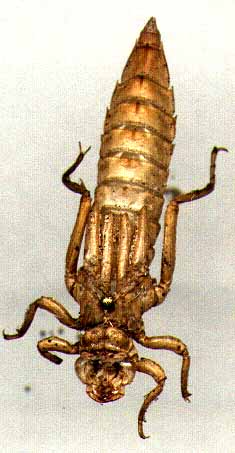 Aquatic Insects of Michigan
Aquatic Insects of Michigan
by Ethan Bright, Museum of Zoology Insect Division and School of Natural Resources and Environment
University of Michigan
- Home
- Species Lists
- Coleoptera
- Diptera
- Ephemeroptera
- Acanthametropodidae
- Ameletidae
- Ametropodidae
- Arthropleidae
- Baetidae
- Baetiscidae
- Behningiidae
- Caenidae
- Ephemerellidae
- Ephemeridae
- Heptageniidae
- Isonychiidae
- Leptohyphidae
- Leptophlebiidae
- Metretopodidae
- Neoephemeridae
- Oligoneuriidae
- Palingeniidae
- Polymitarcyidae
- Potamanthidae
- Pseudironidae
- Siphlonuridae
- Heteroptera
- Hymenoptera
- Lepidoptera
- Megaloptera
- Neuroptera (Sisyridae)
- Odonata
- Orthoptera
- Plecoptera
- Trichoptera
- Other Orders
- Keys/Identification
- Aquatic Insects of Michigan
Dromogomphus (Gomphidae) (Spinylegs) of Michigan - Identification
Two of the three species of Dromogomphus in eastern North American genus are known from Michigan. Nymphs and adults of D. spinosus(figure below, UMMZODO-1247) are widespread in the state, and can be fairly common in rocky lake margins as well as large rivers and streams. Adults of D. spoliatus have recently been recorded in southeastern Michigan, and nymphs are likely to be found in the larger streams of the area.
Westfall and Tennessen (1979) expanded on Wright's (1946) older work to provide the most recent taxonomic treatment for the genus. These are large (last instars usually measure about 32-35 mm), elongate gomphid nymphs, distinctive for their large, dark mid-dorsal abdominal spines, and this character will help distinguish this species from nymphs of Gomphus graslinellus and G. lividus to which there is some resemblance.The dark mid-dorsal abdominal ridge and spines usually are clearly distinguished from the lighter ground color of the abdominal segment, and this color in nymphs and exuviae often remains after long-term preservation in alcohol (EB, pers. obs.). Walker (1958) remarks that D. spinosus species is the most common late summer gomphid of large streams and lakes in southern Ontario. Nymphs apparently crawl several feet from the water's edge upon a log or rock to emerge. Very little is known about the ecology or biology of this genus. In Michigan, adults appear to emerge from mid-June through July, based on observations from F. Locke (July 1940, Washtenaw Co.), E. J. Kormondy (25 June 1953, Douglas Lake, Cheboygan Co.), T. Nowicki (28 June 1997, Green Lake, Benzie Co.) and E. Bright (27 June 1996, Ives Lake, Marquette Co.).
(Taxonomic References: Wright 1946, Westfall and Tennessen 1979, Needham et al. 2000)
Adults
1a a. Pale lateral mesepisternal stripe < 1/4 the width of the dark antehumeral stripe, or absent Dromogomphus spinosus Selys b. Costa and caudal appendages largely black c. Vertex of female with a pair of prominent black spines 1b a. Pale lateral mesepisternal stripe nearly as wise as the dark antehumeral
Dromogomphus spoliatus (Hagen)b. Costa pale, caudal appendages pale or reddish brown c. Vertex of female without black spines
Mature Nymphs
1a a. Middorsal processes on Ab5- or 6-9 (Fig. 2) Dromogomphus spinosus Selys b. Lateral spines on Ab9 about 1.5x the length of those on Ab8 (Fig. 3) c. Small, stout spines along lateral margins of Ab7-9 (Fig. 4) d. End tooth of palpal lobe 2.0x as long as smaller teeth next to it (Fig. 5) Fig. 2
Fig. 3
Fig. 4
Fig. 5
Fig. 2: (6x, dorsal view), Dromogomphus spinosus larva, from Third Sister Lake, Washtenaw Co., Michigan, collected by F. Locke in July 1940. UMMZODO-0562. Fig. 3: (12.5x, dorsal view): Dromogomphus spinosus exuvia, from Ives Lake, Marquette Co., Michigan, collected by M. F. O'Brien on 02 July 1996. UMMZODO-1247; Fig. 4: (12.5x, dorsal view), Dromogomphus spinosus larva, from Third Sister Lake, Washtenaw Co., Michigan, collected by F. Locke in July 1940. UMMZODO-0562.; Fig. 5: (25x, ventral view), Dromogomphus spinosus larva, from Third Sister Lake, Washtenaw Co., Michigan, collected by F. Locke in July 1940. UMMZODO-0562.1b a. Middorsal processes on Ab8-9, absent on Ab5-7 (Fig. 6)
Dromogomphus spoliatus (Hagen)b. Lateral spines on Ab9 about 3.0x as long as those on Ab8 (Fig. 7) c. Small, stout spines along lateral margins of Ab9, sometimes along Ab8, but absent along Ab7 (Fig. 8) d. End tooth of palpal lobe less than 2.0x as long as smaller teeth next to it (Fig. 9)
Fig. 6
Fig. 7
Fig. 8
Fig. 9
Figs. 6 (6x, dorsal view), 7 (12.5x, dorsal view), 8 (12.5x, dorsal view) and 9 (25x, ventral view): Dromogomphus spoliatus exuvia, from Fort Wayne, Allen Co., Indiana, collected by E. B. Williamson on 03 August 1902. UMMZODO-1597.
References
Needham JG, Westfall MJ, May ML. 2000. Dragonflies of North America, Revised Edition. Scientific Publishers, Gainesville, Florida, USA. xv + 939 p.
Walker EM. 1958. The Odonata of Canada and Alaska, Volume 2. University of Toronto Press: Toronto, Ontario, Canada. xii + 318.
Westfall MJ, Tennessen KJ. 1979. Taxonomic clarification within the genus Dromogomphus Selys (Odonata: Gomphidae). The Florida Entomologist 62(3):266-273.
Wright M. 1946. Taxonomic notes on the nymphs of the dragonfly genus Dromogomphus Selys. Journal of the Tennessee Academy of Science 21:183-186.
Page created: July 17, 1998 - Last updated: May 22, 2016